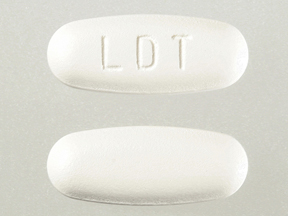Telbivudine Disease Interactions
There are 3 disease interactions with telbivudine.
AZT/telbivudine (applies to telbivudine) myopathy
Major Potential Hazard, High plausibility. Applicable conditions: Myoneural Disorder
Prolonged use of certain nucleoside reverse transcriptase inhibitors (NRTIs) such as zidovudine and telbivudine may commonly cause myopathy, including rare cases of rhabdomyolysis. The myopathy may be dose-related and is characterized by persistent, unexplained muscle aches and/or weakness in conjunction with increases in creatine phosphokinase (CPK) values. Therapy with these NRTIs should be administered cautiously in patients with preexisting myopathy or a myoneural disorder, since it may delay the recognition or confound the diagnosis of a drug-induced musculoskeletal effect. Patients should be advised to report promptly any unusual muscle pain, tenderness or weakness, particularly if accompanied by malaise or fever. NRTI therapy should be interrupted if drug-related myopathy is suspected, and discontinued if myopathy is diagnosed.
Telbivudine (applies to telbivudine) hemodialysis
Moderate Potential Hazard, High plausibility.
Telbivudine is removed by hemodialysis. Up to four hours of hemodialysis can reduce systemic telbivudine exposure by approximately 23%. Telbivudine should be administered after hemodialysis. Following dose interval adjustment for creatinine clearance, no additional dose modification is necessary during routine hemodialysis.
Telbivudine (applies to telbivudine) renal dysfunction
Moderate Potential Hazard, High plausibility.
Telbivudine is primarily eliminated by the kidney. Compared to patients with normal renal function (CrCl above 80 mL/min), systemic exposure (AUC) of single-dose telbivudine increased by 26% in patients with moderate renal dysfunction (CrCl 30 to 49 mL/min) and 136% in patients with end-stage renal disease managed on hemodialysis. Renal clearance decreased by 66% and 91%, respectively, in patients with moderate and severe renal dysfunction (CrCl below 30 mL/min). Adjustment of the dosing interval is recommended for patients with CrCl below 50 mL/min, including patients on dialysis, in accordance with the manufacturer's product labeling.
Switch to professional interaction data
Telbivudine drug interactions
There are 204 drug interactions with telbivudine.
More about telbivudine
- telbivudine consumer information
- Check interactions
- Compare alternatives
- Side effects
- Dosage information
- During pregnancy
- Drug class: nucleoside reverse transcriptase inhibitors (NRTIs)
- Breastfeeding
Related treatment guides
Drug Interaction Classification
| Highly clinically significant. Avoid combinations; the risk of the interaction outweighs the benefit. | |
| Moderately clinically significant. Usually avoid combinations; use it only under special circumstances. | |
| Minimally clinically significant. Minimize risk; assess risk and consider an alternative drug, take steps to circumvent the interaction risk and/or institute a monitoring plan. | |
| No interaction information available. |
See also:
Further information
Always consult your healthcare provider to ensure the information displayed on this page applies to your personal circumstances.


